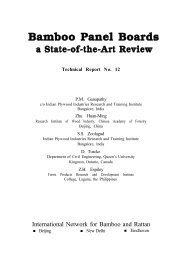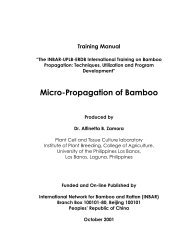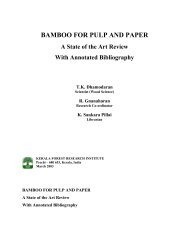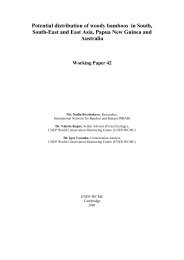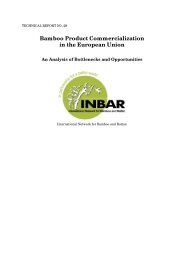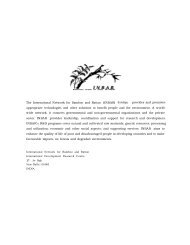The Bamboo and Rattan Sectors in Asia: an Analysis of ... - INBAR
The Bamboo and Rattan Sectors in Asia: an Analysis of ... - INBAR
The Bamboo and Rattan Sectors in Asia: an Analysis of ... - INBAR
Create successful ePaper yourself
Turn your PDF publications into a flip-book with our unique Google optimized e-Paper software.
For example, ratt<strong>an</strong> cutt<strong>in</strong>g permits are available to a r<strong>an</strong>ge <strong>of</strong> applic<strong>an</strong>ts, <strong>in</strong>clud<strong>in</strong>g<br />
Indigenous Cultural Communities (ICCs), cooperatives, private <strong>in</strong>dividuals,<br />
corporations <strong><strong>an</strong>d</strong> ratt<strong>an</strong> gatherers associations. Gatherers' associations have been<br />
established <strong>in</strong> m<strong>an</strong>y places to enable gatherers to apply for permits. Some <strong>of</strong> these<br />
associations have taken up market<strong>in</strong>g responsibilities <strong><strong>an</strong>d</strong>, <strong>in</strong> some cases, perform<br />
some semi-process<strong>in</strong>g.<br />
<strong>The</strong>re are two levels <strong>of</strong> traders <strong>in</strong>volved <strong>in</strong> gett<strong>in</strong>g ratt<strong>an</strong> from the permit holders<br />
to the semi-processors <strong><strong>an</strong>d</strong> m<strong>an</strong>ufacturers. <strong>The</strong>re are small-scale local traders who<br />
normally deal with just one or very few permit holders. <strong>The</strong>se traders h<strong><strong>an</strong>d</strong>le a fairly<br />
small volume. <strong>The</strong>ir sales are to small m<strong>an</strong>ufacturers <strong>in</strong> their area, or to larger,<br />
prov<strong>in</strong>cial traders. Larger prov<strong>in</strong>cial traders buy from permit holders or from local<br />
traders <strong><strong>an</strong>d</strong> sell directly to semi-processors/retailers or m<strong>an</strong>ufacturers. <strong>The</strong>y normally<br />
have higher capital availability, pay their suppliers <strong>in</strong> cash <strong><strong>an</strong>d</strong> are paid <strong>in</strong> cash by<br />
their buyers. Most have regular bus<strong>in</strong>ess partners, though some spot sales do occur.<br />
<strong>The</strong> larger traders have large stockyards <strong><strong>an</strong>d</strong> storage facilities, vehicles <strong><strong>an</strong>d</strong> semiprocess<strong>in</strong>g<br />
mach<strong>in</strong>es, <strong><strong>an</strong>d</strong> even employ full-time adm<strong>in</strong>istrative staff, <strong><strong>an</strong>d</strong> other regular<br />
<strong><strong>an</strong>d</strong> contractual workers.<br />
Tr<strong>an</strong>sactions between raw material traders <strong><strong>an</strong>d</strong> semi-processors or f<strong>in</strong>ished<br />
product m<strong>an</strong>ufacturers are more competitive th<strong>an</strong> tr<strong>an</strong>sactions at earlier stages <strong>in</strong> the<br />
PCS. <strong>The</strong> prov<strong>in</strong>cial traders <strong>of</strong>ten have several customers <strong><strong>an</strong>d</strong> so they have barga<strong>in</strong><strong>in</strong>g<br />
power. Even so, strong bus<strong>in</strong>ess relationships dom<strong>in</strong>ate the trade. Most tr<strong>an</strong>sactions<br />
are carried out as bulk sales between established bus<strong>in</strong>ess partners. In some cases,<br />
<strong>in</strong>dustrial buyers extend credit or adv<strong>an</strong>ce payments to traders. Small-scale<br />
m<strong>an</strong>ufacturers buy their raw materials from gatherer associations or private permittees<br />
with<strong>in</strong> the town or prov<strong>in</strong>ce that is most accessible to them. Larger m<strong>an</strong>ufacturers<br />
require larger qu<strong>an</strong>tities <strong>of</strong> <strong>in</strong>puts <strong><strong>an</strong>d</strong> need to have regular <strong><strong>an</strong>d</strong> reliable supplies.<br />
<strong>The</strong> semi-process<strong>in</strong>g <strong><strong>an</strong>d</strong> the m<strong>an</strong>ufactur<strong>in</strong>g stages require specialized mach<strong>in</strong>es,<br />
such as a polish<strong>in</strong>g gr<strong>in</strong>der or a surface mill<strong>in</strong>g mach<strong>in</strong>e <strong><strong>an</strong>d</strong> ratt<strong>an</strong> peel <strong><strong>an</strong>d</strong> core<br />
process<strong>in</strong>g mach<strong>in</strong>es. Some private traders <strong><strong>an</strong>d</strong> some gatherers associations have<br />
<strong>in</strong>vested <strong>in</strong> this mach<strong>in</strong>ery. In other cases the f<strong>in</strong>al product m<strong>an</strong>ufacturers buy raw<br />
c<strong>an</strong>e <strong><strong>an</strong>d</strong> do all semi-process<strong>in</strong>g <strong><strong>an</strong>d</strong> f<strong>in</strong>al m<strong>an</strong>ufactur<strong>in</strong>g. Numerous small family<br />
enterprises exist, as well as some large <strong><strong>an</strong>d</strong> highly mech<strong>an</strong>ized units. Small-scale<br />
m<strong>an</strong>ufacturers buy their raw materials from associations or private permittees with<strong>in</strong><br />
the town or prov<strong>in</strong>ce most accessible to them. Medium- <strong><strong>an</strong>d</strong> large-scale m<strong>an</strong>ufacturers<br />
buy larger qu<strong>an</strong>tities from traders. <strong>The</strong>y have large factory areas <strong><strong>an</strong>d</strong> complete facilities.<br />
<strong>The</strong>y employ up to 150 <strong>in</strong>-house employees, <strong>in</strong>clud<strong>in</strong>g full-time adm<strong>in</strong>istrative staff,<br />
plus numerous sub-contractors (up to 600 per firm).<br />
Labor work<strong>in</strong>g <strong>in</strong> medium to large semi-process<strong>in</strong>g or m<strong>an</strong>ufactur<strong>in</strong>g unit c<strong>an</strong><br />
earn wages <strong>in</strong> the r<strong>an</strong>ge <strong>of</strong> P2 000-3 000 per month. Normally this is their pr<strong>in</strong>cipal<br />
occupation. Also, m<strong>an</strong>y subcontractors are engaged, especially at peak times. M<strong>an</strong>y<br />
<strong>of</strong> these people do other jobs as well, but ratt<strong>an</strong> work is the ma<strong>in</strong> occupation for<br />
most.<br />
48



